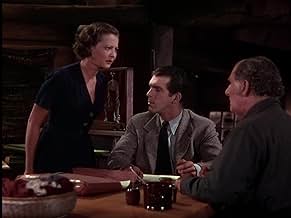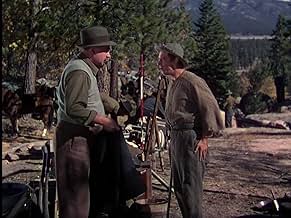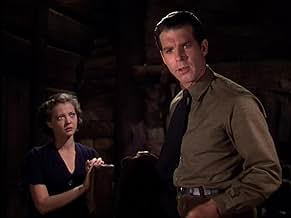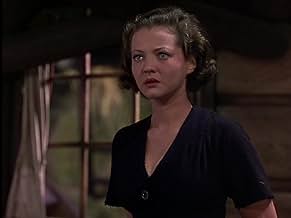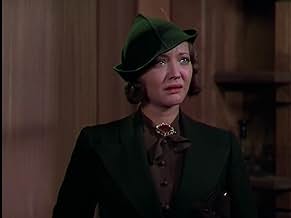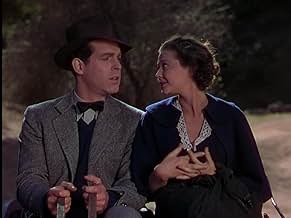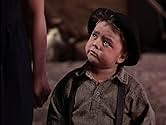NOTE IMDb
6,8/10
1,5 k
MA NOTE
Ajouter une intrigue dans votre langueA railroad man from the city befriends a mountain girl in a Kentucky family feud.A railroad man from the city befriends a mountain girl in a Kentucky family feud.A railroad man from the city befriends a mountain girl in a Kentucky family feud.
- Réalisation
- Scénario
- Casting principal
- Nommé pour 1 Oscar
- 5 victoires et 2 nominations au total
George 'Spanky' McFarland
- Buddie Tolliver
- (as Spanky McFarland)
Samuel S. Hinds
- Sheriff
- (as Samuel Hinds)
Henry Brandon
- Wade Falin
- (as Henry Kleinbach)
Jess Barker
- Merd Falin
- (as Philip Barker)
Avis à la une
The movie's an affecting tale of feuding backwoods families, who must also make adjustments to encroaching modern world. I was expecting a Romeo-Juliet situation with the families, but that's surprisingly not the case. Instead June (Sidney) has to decide between her cousin Dave (Fonda) and outsider Hale (MacMurray). Tradition favors Dave, but her heart favors Hale. At the same time, railroad developers are crossing land owned by each family, and neither the Tollivers nor the Falins wants to accommodate their hereditary enemy. They'd rather shoot each other if they get the chance. And who knows how the enmity started, except now it's part of both families' tradition. If the movie's flawed, it's with the use of of popular backwoods stereotypes.
Apparently this was the first outdoor Technicolor feature (IMDB), but you'd never know it. Visually the film is quite striking, with a lot of beautiful outdoor compositions. Also, you'd never guess these were filmed just 35-miles east of LA in the San Bernardino mountains. The acting too is first-rate—a soulful Sydney, an ornery Fonda, and an underrated MacMurray. Then there's Sherlock Holmes' favorite Dr. Watson, Nigel Bruce, in a non-comedic role. Needless to say, that took some adjustment for this old Sherlock fan. In fact, there're a couple other unexpected cast members, as well: Little Rascal Spanky McFarland and comedic Fuzzy Knight. And, of course, mustn't forget everyone's favorite hard-scrabble mom, Beulah Bondi, as the long-suffering ma Tolliver.
I like the way the movie works the culture clash between tradition and modernity into the plot. The railroad company pays big money for land use, and that along with a railway to service the expected coal deposits, is bringing the backwoods into the modern age, as June's evolution shows. Of course, not everyone's supportive of change, particularly dad Tolliver (Stone). The movie has some uncommonly poignant moments, especially that final sequence, which conveys an extraordinary emotional power. As a kid, I recall bawling at it, and even now as a geezer, it brought a tear to the eye. As I see it, Fuzzy and his dog are mourning not only friends but the passing of a simpler way of life.
All in all, the movie is surprisingly good, with a strong story, commanding visuals, and a thoughtful subtext. So don't pass it up because of a relative obscurity.
Apparently this was the first outdoor Technicolor feature (IMDB), but you'd never know it. Visually the film is quite striking, with a lot of beautiful outdoor compositions. Also, you'd never guess these were filmed just 35-miles east of LA in the San Bernardino mountains. The acting too is first-rate—a soulful Sydney, an ornery Fonda, and an underrated MacMurray. Then there's Sherlock Holmes' favorite Dr. Watson, Nigel Bruce, in a non-comedic role. Needless to say, that took some adjustment for this old Sherlock fan. In fact, there're a couple other unexpected cast members, as well: Little Rascal Spanky McFarland and comedic Fuzzy Knight. And, of course, mustn't forget everyone's favorite hard-scrabble mom, Beulah Bondi, as the long-suffering ma Tolliver.
I like the way the movie works the culture clash between tradition and modernity into the plot. The railroad company pays big money for land use, and that along with a railway to service the expected coal deposits, is bringing the backwoods into the modern age, as June's evolution shows. Of course, not everyone's supportive of change, particularly dad Tolliver (Stone). The movie has some uncommonly poignant moments, especially that final sequence, which conveys an extraordinary emotional power. As a kid, I recall bawling at it, and even now as a geezer, it brought a tear to the eye. As I see it, Fuzzy and his dog are mourning not only friends but the passing of a simpler way of life.
All in all, the movie is surprisingly good, with a strong story, commanding visuals, and a thoughtful subtext. So don't pass it up because of a relative obscurity.
8tavm
Just watched this Technicolor Paramount feature (The first of the kind that was shot outdoors) on YouTube. While it had stars like Fred MacMurray, Henry Fonda, and Sylvia Sidney, the main reason I was interested in this movie was because of one Spanky McFarland, who at the time was still a member of "Our Gang". This was a compelling story of a couple of feuding families and one outsider played by MacMurray who's trying to build a railroad around both respective groups' areas. There's also a romantic rivalry between Fonda and MacMurray for Sidney. Also appearing were Beulah Bondi, Nigel Bruce, and Samuel Hinds as the Sheriff. (If anyone is familiar with me, they know my favorite movie is It's a Wonderful Life and I like noting actors in that movie in other films like Bondi and Hinds who were married in the latter) Then there's Fuzzy Knight who's a charmer as something of a Greek chorus singing songs like "Twlight on the Trail" and the Oscar-nominated "A Melody from the Sky". Incidentally, while Knight sings the latter, Fonda whistles and Spanky hums and this was a couple of years before Spanky's "Our Gang" co-star Alfalfa sung part of this tune in the short The Little Ranger (which McFarland doesn't appear in). Anyway, this was a fine showcase for the Technicolor photography as kudos to director Henry Hathaway for making every scene count as this was a most entertaining drama with a couple of touching, though tragic, scenes at the end. So on that note, I highly recommend The Trail of the Lonesome Pine.
I bought a video of this film on Amazon.com after reading the 1908 novel by John Fox Jr. and enjoying it very much. I waited 4 whole months for Amazon to locate a copy and ship it to me. Then I settled down to watch it and almost fell asleep. I was disappointed after all that wait.
Sylvia Sidney and Fred MacMurray were terribly miscast as the leads June and Jack, Fred more so than Sylvia. Henry Fonda was very good as Dave, although his lines were hokey. The script was not true to the book at all; that was the main problem. All the protective tenderness the lead male Jack felt for the girl June, so beautifully portrayed in the novel, was totally missing in Fred MacMurray's performance. And then to top it off they had little Spanky from the Our Gang series in it as the little brother of June, his chubby face and coy demeanor were distractions from the main action of the story. The songs that were sung were annoying too; had no place in the story. It would have been better if they had spent money on a better musical soundtrack without characters singing all the time, especially in dramatic scenes. What were they thinking? (no doubt, of sheet music sales). Some outdoor scenes were beautiful filmed in color but that alone cannot hold the viewer's interest in the movie. Even the significance and symbolism of the Pine Tree in June and Jack's relationship wasn't portrayed in the film as it should have been.
Anyway, my advice here is to skip the film and just read the book and enjoy it. Since this story is in the public domain it could really be updated today and make a nice film. Maybe someday some studio or independent filmmaker will consider it. There were 4 silent versions and an animated version made prior to this film, so obviously the story is a classic one that can be enjoyed by new generations, if told well and with sensitivity and faithfulness to the book by John Fox.
Sylvia Sidney and Fred MacMurray were terribly miscast as the leads June and Jack, Fred more so than Sylvia. Henry Fonda was very good as Dave, although his lines were hokey. The script was not true to the book at all; that was the main problem. All the protective tenderness the lead male Jack felt for the girl June, so beautifully portrayed in the novel, was totally missing in Fred MacMurray's performance. And then to top it off they had little Spanky from the Our Gang series in it as the little brother of June, his chubby face and coy demeanor were distractions from the main action of the story. The songs that were sung were annoying too; had no place in the story. It would have been better if they had spent money on a better musical soundtrack without characters singing all the time, especially in dramatic scenes. What were they thinking? (no doubt, of sheet music sales). Some outdoor scenes were beautiful filmed in color but that alone cannot hold the viewer's interest in the movie. Even the significance and symbolism of the Pine Tree in June and Jack's relationship wasn't portrayed in the film as it should have been.
Anyway, my advice here is to skip the film and just read the book and enjoy it. Since this story is in the public domain it could really be updated today and make a nice film. Maybe someday some studio or independent filmmaker will consider it. There were 4 silent versions and an animated version made prior to this film, so obviously the story is a classic one that can be enjoyed by new generations, if told well and with sensitivity and faithfulness to the book by John Fox.
Only yesterday i was watching an old sitcom "My 3 Sons' starring Fred. I noticed that the teacher's role was played by Sidney...and right away I made the connection to this film, when my big sister took me to the movies. It was my first viewing of a Technicolor movie and as a kid I was anxious to see "Spanky". It was too grown up for me at 8 years old to absorb the story line. I was more taken with the color, Spanky and the song they kept playing throughout. I liked the song and recall, the theater showed a Popeye comedy which was in color also, and the hit song that was played in it was "Did You ever see a Dream Walking, well I did"...I also noticed that my sister and her boyfriend were smooching on sneaks...LOL
THE TRAIL OF THE LONESOME PINE (1936) is a landmark color film of considerable dramatic power that has been neglected in Hollywood history. It was the second full-length feature to be produced in the newly-developed 3 strip Technicolor process. The first Technicolor feature, BECKY SHARP, had opened the previous year (1935) but did not find audience favor. There is strong evidence to suggest that THE TRAIL OF THE LONESOME PINE was the film that really popularized color.
Aside from the superb color photography, the film has much to recommend it. There are very strong performances, particularly that of Sylvia Sidney as the backwoods mountain girl - a very convincing portrayal. She is supported by two handsome newcomers, Henry Fonda and Fred MacMurray, plus veterans such as Fred Stone, Beulah Bondi, and Spanky MacFarland. The story line is very compelling and there is the strong direction of Henry Hathaway (LIVES OF A BENGAL LANCER, KISS OF DEATH, TRUE GRIT). In its original release, audiences reportedly burst into applause while viewing some of the color scenes. The film was a box office smash for Paramount, playing to packed houses in both large and small towns. (This is well documented.) It remains compelling entertainment today. The high-quality color photography was very much in evidence in the VHS tape that MCA released in the Nineties. It is to be hoped that the same high quality will be seen in the projected 2009 DVD release of this beloved film.
Aside from the superb color photography, the film has much to recommend it. There are very strong performances, particularly that of Sylvia Sidney as the backwoods mountain girl - a very convincing portrayal. She is supported by two handsome newcomers, Henry Fonda and Fred MacMurray, plus veterans such as Fred Stone, Beulah Bondi, and Spanky MacFarland. The story line is very compelling and there is the strong direction of Henry Hathaway (LIVES OF A BENGAL LANCER, KISS OF DEATH, TRUE GRIT). In its original release, audiences reportedly burst into applause while viewing some of the color scenes. The film was a box office smash for Paramount, playing to packed houses in both large and small towns. (This is well documented.) It remains compelling entertainment today. The high-quality color photography was very much in evidence in the VHS tape that MCA released in the Nineties. It is to be hoped that the same high quality will be seen in the projected 2009 DVD release of this beloved film.
Le saviez-vous
- AnecdotesParamount's first Technicolor feature and the first feature to be shot in Three-Strip Technicolor outside of a studio environment (on location).
- GaffesThe mud on June Tolliver changes thickness and shape between shots. It also changes from wet to dry and then back to wet.
- Citations
Melissa Tolliver: I was born old...
- Crédits fousThe opening credits (except for the Paramount logo) all appear as if they had been printed on tree barks.
- ConnexionsEdited into The Our Gang Story (1994)
Meilleurs choix
Connectez-vous pour évaluer et suivre la liste de favoris afin de recevoir des recommandations personnalisées
- How long is The Trail of the Lonesome Pine?Alimenté par Alexa
Détails
- Date de sortie
- Pays d’origine
- Langue
- Aussi connu sous le nom de
- The Trail of the Lonesome Pine
- Lieux de tournage
- Sociétés de production
- Voir plus de crédits d'entreprise sur IMDbPro
- Durée1 heure 42 minutes
- Rapport de forme
- 1.37 : 1
Contribuer à cette page
Suggérer une modification ou ajouter du contenu manquant

